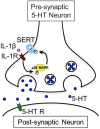A dialogue between the immune system and brain, spoken in the language of serotonin
- PMID: 23336044
- PMCID: PMC3547518
- DOI: 10.1021/cn300186b
A dialogue between the immune system and brain, spoken in the language of serotonin
Abstract
Neuropsychiatric disorders have long been linked to both immune system activation and alterations in serotonin (5-HT) signaling. In the CNS, the contributions of 5-HT modulate a broad range of targets, most notably, hypothalamic, limbic and cortical circuits linked to the control of mood and mood disorders. In the periphery, many are aware of the production and actions of 5-HT in the gut but are unaware that the molecule and its receptors are also present in the immune system where evidence suggests they contribute to the both innate and adaptive responses. In addition, there is clear evidence that the immune system communicates to the brain via both humoral and neuronal mechanisms, and that CNS 5-HT neurons are a direct or indirect target for these actions. Following a brief primer on the immune system, we describe our current understanding of the synthesis, release, and actions of 5-HT in modulating immune function, including the expression of 5-HT biosynthetic enzymes, receptors, and transporters that are typically studied with respect to the roles in the CNS. We then orient our presentation to recent findings that pro-inflammatory cytokines can modulate CNS 5-HT signaling, leading to a conceptualization that among the many roles of 5-HT in the body is an integrated physiological and behavioral response to inflammatory events and pathogens. From this perspective, altered 5-HT/immune conversations are likely to contribute to risk for neurobehavioral disorders historically linked to compromised 5-HT function or ameliorated by 5-HT targeted medications, including depression and anxiety disorders, obsessive-compulsive disorder (OCD), and autism. Our review raises the question as to whether genetic variation impacting 5-HT signaling genes may contribute to maladaptive behavior as much through perturbed immune system modulation as through altered brain mechanisms. Conversely, targeting the immune system for therapeutic development may provide an important opportunity to treat mental illness.
Figures



References
-
- Canli T.; Lesch K. P. (2007) Long story short: the serotonin transporter in emotion regulation and social cognition. Nat. Neurosci. 10, 1103–1109. - PubMed
-
- Monti J. M. (2011) Serotonin control of sleep-wake behavior. Sleep Med. Rev. 15, 269–281. - PubMed
-
- Blundell J. E. (1984) Serotonin and appetite. Neuropharmacology 23, 1537–1551. - PubMed
Publication types
MeSH terms
Substances
Grants and funding
LinkOut - more resources
Full Text Sources
Other Literature Sources
Medical

